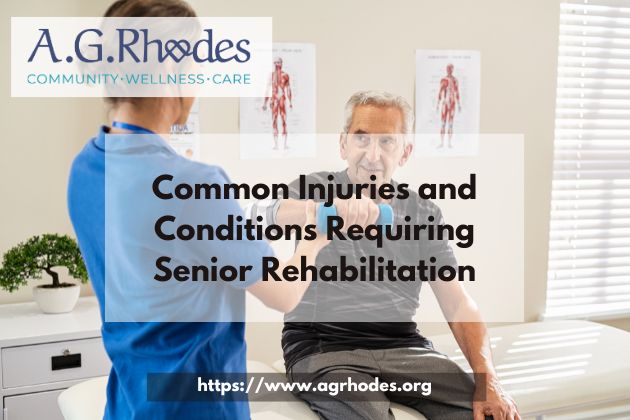 Aging is an inevitable journey, and with it comes an increased susceptibility to injuries and chronic conditions that impact mobility and independence. Seniors often experience health challenges that necessitate rehabilitation to restore function, reduce pain, and enhance their quality of life. Whether due to falls, surgeries, or progressive neurological diseases, rehabilitation plays a pivotal role in ensuring that older adults regain their confidence and ability to perform daily tasks.
Aging is an inevitable journey, and with it comes an increased susceptibility to injuries and chronic conditions that impact mobility and independence. Seniors often experience health challenges that necessitate rehabilitation to restore function, reduce pain, and enhance their quality of life. Whether due to falls, surgeries, or progressive neurological diseases, rehabilitation plays a pivotal role in ensuring that older adults regain their confidence and ability to perform daily tasks.
Fractures and Bone Injuries
Falls are the leading cause of fractures among seniors, primarily due to weakened bones from osteoporosis or balance issues. Hip fractures, wrist fractures, and vertebral compression fractures are particularly common. These injuries can be debilitating, often requiring surgical intervention followed by extensive rehabilitation. Physical therapy helps strengthen muscles, improve balance, and prevent future falls, while occupational therapy assists in adapting daily activities to prevent strain on injured bones.
Joint Replacements and Mobility Issues
As the wear and tear on joints accumulate over the years, many seniors undergo hip or knee replacement surgeries to regain mobility and reduce chronic pain. However, surgery alone is not the solution—rehabilitation is crucial for restoring strength and function. Post-operative therapy focuses on reducing stiffness, improving range of motion, and gradually rebuilding endurance. Structured exercises, hydrotherapy, and assistive devices like walkers and canes facilitate a smoother recovery process.
Neurological Conditions and Stroke Recovery
A stroke can have devastating effects on a senior’s ability to move, speak, and perform basic functions. Depending on the severity, strokes can lead to partial paralysis, coordination issues, and cognitive impairments. Rehabilitation focuses on retraining the brain through repetitive movement exercises, speech therapy, and balance training. The goal is to maximize independence and enhance the brain’s ability to rewire itself through neuroplasticity.
Arthritis and Chronic Pain Management
Arthritis is a relentless condition that causes joint inflammation, stiffness, and persistent pain, making everyday tasks arduous. Rheumatoid arthritis and osteoarthritis are the most prevalent forms affecting seniors. Rehabilitation strategies include low-impact exercises, aquatic therapy, and pain management techniques such as heat therapy and electrical stimulation. Strengthening the muscles around affected joints reduces stress on them, improving overall mobility and function.
Cardiopulmonary Rehabilitation
Heart disease and respiratory conditions such as chronic obstructive pulmonary disease (COPD) are common in older adults, often leading to diminished endurance and increased fatigue. Cardiopulmonary rehabilitation programs focus on controlled exercise regimens that improve heart efficiency and lung capacity. Breathing exercises, monitored cardiovascular workouts, and nutritional counseling help seniors regain stamina and prevent future complications.
Cognitive and Neuromuscular Disorders
Neurological conditions such as Parkinson’s disease and dementia present unique rehabilitation challenges. These disorders can impair movement, coordination, and cognitive function, making daily activities difficult. Rehabilitation aims to slow disease progression and maintain as much independence as possible. Balance training, flexibility exercises, and cognitive therapy techniques like memory recall activities help seniors stay engaged and functional for longer.
Post-Surgical Recovery
Many seniors undergo surgeries such as spinal fusions, rotator cuff repairs, or abdominal procedures that require extensive post-operative rehabilitation. Without proper therapy, recovery can be slow and painful, leading to a loss of strength and function. A structured rehabilitation plan that includes physical therapy, pain management strategies, and gradual reintegration into daily activities is essential to regain independence.
The Role of Occupational and Physical Therapy
Physical therapy and occupational therapy are often confused, but both serve distinct yet complementary roles in rehabilitation. Physical therapy focuses on restoring movement, strength, and flexibility, while occupational therapy helps seniors relearn essential daily activities such as dressing, cooking, and using assistive devices. Together, they provide a holistic approach to rehabilitation, ensuring that seniors can maintain autonomy and continue living fulfilling lives.
Conclusion
Rehabilitation is a cornerstone of senior healthcare, enabling older adults to recover from injuries, surgeries, and chronic conditions with dignity and resilience. By embracing structured rehabilitation programs, seniors can enhance their mobility, manage pain, and preserve their independence. Encouraging proactive recovery and long-term wellness ensures that aging remains a journey of strength rather than a struggle.

